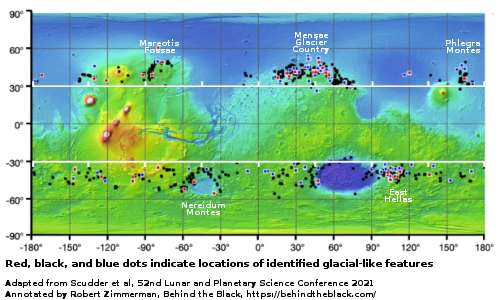The glaciers on Mars are almost pure ice with only a thin cover of dust and debris

A map of glaciers on Mars.
According to new research, scientists now think that the glaciers on Mars are almost pure ice, protected from sublimation by a thin cover of dust and debris.
Work over the last 20 years has demonstrated that at least some of these glaciers are mostly pure ice with only a thin cover of rock and dust, but according to a new paper published in Icarus, glaciers all over the planet actually contain more than 80% water ice, a significant finding. Ultimately, this means that Mars’s glacial ice deposits are nearly pure across the globe, providing a clearer understanding of Mars’ climate history and a possible resource for future utilization.
The researchers analyzed mid-latitude glaciers at five different locations in both the north and south hemispheres, and found that at every location the data suggested almost pure ice.
The map to the right, from earlier research, shows the prevalence of near-surface ice once you get above 30 degrees latitude. From the poles to the mid-latitudes it appears there is an ice sheet or “ice table” just below the surface. In the mid-latitudes glaciers dominate, as this appears to be the region where that ice is beginning to dissipate. In the equatorial regions little or no near-surface ice has been detected, though there has been some evidence in some places of ice at deeper depths.
This data once again demonstrates that Mars is not a desert like the Sahara, as we once believed. Instead, it more resembles Antarctica, where there is ice everywhere that simply needs to be processed for use.
On Christmas Eve 1968 three Americans became the first humans to visit another world. What they did to celebrate was unexpected and profound, and will be remembered throughout all human history. Genesis: the Story of Apollo 8, Robert Zimmerman's classic history of humanity's first journey to another world, tells that story, and it is now available as both an ebook and an audiobook, both with a foreword by Valerie Anders and a new introduction by Robert Zimmerman.
The print edition can be purchased at Amazon or from any other book seller. If you want an autographed copy the price is $60 for the hardback and $45 for the paperback, plus $8 shipping for each. Go here for purchasing details. The ebook is available everywhere for $5.99 (before discount) at amazon, or direct from my ebook publisher, ebookit. If you buy it from ebookit you don't support the big tech companies and the author gets a bigger cut much sooner.
The audiobook is also available at all these vendors, and is also free with a 30-day trial membership to Audible.
"Not simply about one mission, [Genesis] is also the history of America's quest for the moon... Zimmerman has done a masterful job of tying disparate events together into a solid account of one of America's greatest human triumphs."--San Antonio Express-News

A map of glaciers on Mars.
According to new research, scientists now think that the glaciers on Mars are almost pure ice, protected from sublimation by a thin cover of dust and debris.
Work over the last 20 years has demonstrated that at least some of these glaciers are mostly pure ice with only a thin cover of rock and dust, but according to a new paper published in Icarus, glaciers all over the planet actually contain more than 80% water ice, a significant finding. Ultimately, this means that Mars’s glacial ice deposits are nearly pure across the globe, providing a clearer understanding of Mars’ climate history and a possible resource for future utilization.
The researchers analyzed mid-latitude glaciers at five different locations in both the north and south hemispheres, and found that at every location the data suggested almost pure ice.
The map to the right, from earlier research, shows the prevalence of near-surface ice once you get above 30 degrees latitude. From the poles to the mid-latitudes it appears there is an ice sheet or “ice table” just below the surface. In the mid-latitudes glaciers dominate, as this appears to be the region where that ice is beginning to dissipate. In the equatorial regions little or no near-surface ice has been detected, though there has been some evidence in some places of ice at deeper depths.
This data once again demonstrates that Mars is not a desert like the Sahara, as we once believed. Instead, it more resembles Antarctica, where there is ice everywhere that simply needs to be processed for use.
On Christmas Eve 1968 three Americans became the first humans to visit another world. What they did to celebrate was unexpected and profound, and will be remembered throughout all human history. Genesis: the Story of Apollo 8, Robert Zimmerman's classic history of humanity's first journey to another world, tells that story, and it is now available as both an ebook and an audiobook, both with a foreword by Valerie Anders and a new introduction by Robert Zimmerman.
The print edition can be purchased at Amazon or from any other book seller. If you want an autographed copy the price is $60 for the hardback and $45 for the paperback, plus $8 shipping for each. Go here for purchasing details. The ebook is available everywhere for $5.99 (before discount) at amazon, or direct from my ebook publisher, ebookit. If you buy it from ebookit you don't support the big tech companies and the author gets a bigger cut much sooner.
The audiobook is also available at all these vendors, and is also free with a 30-day trial membership to Audible.
"Not simply about one mission, [Genesis] is also the history of America's quest for the moon... Zimmerman has done a masterful job of tying disparate events together into a solid account of one of America's greatest human triumphs."--San Antonio Express-News

